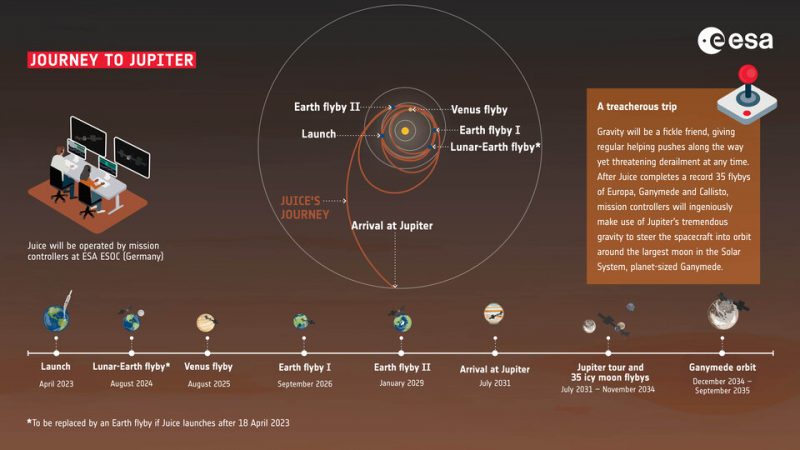? Shocking RIME update ?
The RIME antenna on @ESA_JUICE is free!!!
This Juice Monitoring Camera GIF shows the moments after the Flight Control Team at ESA #MissionControl fired the remaining 'actuator' on the jammed bracket.
More info: https://t.co/QzZdleTdgt pic.twitter.com/T96RIg3hKA
— ESA Operations (@esaoperations) May 12, 2023
Update: If you’ve been following the European Space Agency’s JUICE mission, you might have heard the worrying news that its primary antenna failed to deploy in the weeks following its April 14, 2023, launch. Now, after 3 weeks of troubleshooting, the antenna is fixed! As the spacecraft travels through deep space, JUICE mission control had tried using thrusters to shake the antenna, before warming the jammed components in the sun. Finally, the team fired a mechanical device called an actuator, which was able to shock the antenna free on May 12. This RIME antenna, which stands for Radar for Icy Moons Exploration, will be used to study the structure of Jupiter’s icy moons down to a depth of 5.5 miles (9 km) when it finally reaches the gas giant in July 2031.
JUICE mission launch was April 14, 2023
ESA‘s JUICE mission launched on April 14, 2023, after a one-day delay due to lightning at its spaceport in French Guiana. The spacecraft lifted off successfully into cloudy skies, beginning a multi-year mission to Jupiter and its icy moons.
As often happens with missions to the outer solar system, the spacecraft will take a circuitous route to Jupiter. But – starting in 2031, when it arrives at the giant planet – it’ll perform 35 flybys of the Galilean moons Ganymede, Callisto and Europa, before going into orbit around the largest moon, Ganymede.
JUICE stands for JUpiter ICy moons Explorer.

Watch the launch
You can watch the JUICE launch on April 14, 2023, in the video player below:
JUICE mission goals
ESA said its goals for JUICE are to:
… make detailed observations of the giant gas planet and its three large ocean-bearing moons – Ganymede, Callisto and Europa – with a suite of remote sensing, geophysical and in situ instruments.
And, ESA said, the mission will characterize these moons as both planetary objects and possible habitats.
ESA hopes that a wider study of the Jupiter system can be used as an archetype for gas giant planets and their moons, across our Milky Way galaxy.
Liftoff for humankind’s next bold mission to the outer Solar System – #ESAJuice onboard @Ariane5 #VA260 ? ?#DestinationJupiter #ExploreFarther https://t.co/nuYjsCR6Ar
— ESA's Juice mission (@ESA_JUICE) April 14, 2023
Why JUICE will study Europa
JUICE will arrive at Jupiter in 2031. One of the moons it will observe is perhaps the most fascinating of the Jovian moons to Earthly scientists: Europa. This moon is thought to have an ocean of liquid water under its ice crust (also made of water ice). And JUICE is designed to look for the sort of chemistry on Europa that is essential to life on Earth … For example, organic molecules, or molecules containing carbon that are key to life on Earth.
JUICE also aims to understand the formation of Europa’s surface features and the composition of any non-water-ice material.
Why JUICE will study Ganymede
After a series of flybys of Jupiter and three of its large, icy moons, JUICE will eventually settle into an orbit around the largest moon, Ganymede. JUICE will orbit Ganymede down to 125 miles (200 km) for about three years. It’ll end its mission with an impact on the moon’s surface.
While at Ganymede, JUICE has many science objectives. They include:
- Characterization of the ocean layers and detection of possible subsurface water reservoirs.
- Topographical, geological and compositional mapping of the surface.
- Study of the physical properties of the icy crusts.
- Characterization of the internal mass distribution, dynamics and evolution of the interiors.
- Investigation of the exosphere.
- Study of Ganymede’s intrinsic magnetic field and its interactions with the Jovian magnetosphere.
Having a better understanding of this wet, cold world will also help us understand possible distant worlds around other suns, scientists say.
JUICE mocktails
Earlier this year, ESA had a little fun with the acronym JUICE, by holding a space juice contest. Check out these beautiful mocktails, and find the recipes here.

JUICE art, from kids
ESA also invited kids from around the world to create JUICE-inspired artwork. Read more about the contest here. The winning entry – submitted by 8-year-old Yaryna from Ukraine – is going to space! It’s painted on the Ariane 5 rocket, which will launch JUICE.
Did you spot the beautiful artwork on the nose of the #Ariane5 fairing? Children from all over the world were invited to create a piece of art inspired by #ESAJuice and the winning design by ten-year-old Yaryna can be seen here. https://t.co/3wj377p0md pic.twitter.com/i5c7aGbTmw
— ESA's Juice mission (@ESA_JUICE) April 12, 2023
Bottom line: The JUICE mission successfully launched to Jupiter and its moons on April 14, 2023, from ESA’s spaceport in French Guiana. After three weeks of troubleshooting, ESA announced on May 12 that the primary antenna for the JUICE mission has finally deployed. JUICE will explore Jupiter and its icy moons starting in 2031.
Read more: Icy moons’ puzzling features may be due to salty ice
The post Jammed JUICE mission antenna free at last first appeared on EarthSky.
0 Commentaires